- Details
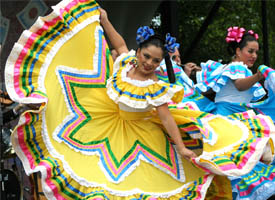 Cities across the United States are celebrating Cinco de Mayo today with festivals, parades and other public events.
Cities across the United States are celebrating Cinco de Mayo today with festivals, parades and other public events.
The holiday is a celebration of the Mexican army’s defeat of the French in an 1862 battle during the Franco-Mexican War, which lasted from 1861 until 1867. Widely celebrated in the United States as a celebration of Mexican-American culture, the holiday is not nearly as celebrated in Mexico outside of Puebla, where the defeat of the French took place.
Celebrations over the weekend brought an estimated 100,000 people to Chicago’s Douglas Park in celebration of Cinco de Mayo, which included a parade on the city’s West Side.
Learn more:
Cinco de Mayo – History.com
Cinco de Mayo celebrations begin with West Side parade - ABC 7 Chicago
Did You Know? Forty-two years ago, the Willis (Sears) Tower became the tallest building in the world
- Details
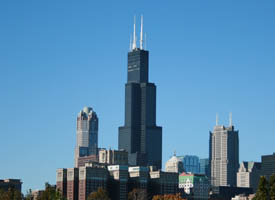 Forty-two years ago this week, on a cool, breezy day on the western edge of downtown Chicago, engineers placed the final steel girder into the sky, topping out the Sears Tower and officially making it the tallest building in the world. It would be another three months before the building, designed by Fazlur R. Khan, would reach its working capacity of 15,000 people.
Forty-two years ago this week, on a cool, breezy day on the western edge of downtown Chicago, engineers placed the final steel girder into the sky, topping out the Sears Tower and officially making it the tallest building in the world. It would be another three months before the building, designed by Fazlur R. Khan, would reach its working capacity of 15,000 people.
Since its opening, the building has not only housed Sears, Roebuck & Company, but many other businesses as well, from fine-dining restaurants to prestigious law firms. In 1996, the Petronas Towers in Kuala Lampur, Malaysia, ended the Sears Tower’s 25-year reign as the tallest building in the world.
In 2009, the building was renamed the Willis Tower after a large portion of it was purchased by the Willis Group. Today, the Willis Tower is the second-tallest building in the United States after the recently completed One World Trade Center building in New York City.
Learn more:
Wonders of the World – PBS.org
Dr. Fazlur R. Khan
- Details
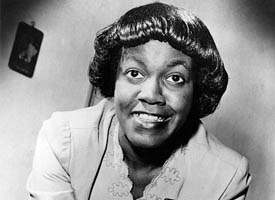 Gwendolyn Brooks was awarded a Pulitzer Prize for her book Annie Allen on May 1, 1950, making her the first African-American to receive the award. Annie Allen told the story of an African American girl’s passage from childhood to womanhood.
Gwendolyn Brooks was awarded a Pulitzer Prize for her book Annie Allen on May 1, 1950, making her the first African-American to receive the award. Annie Allen told the story of an African American girl’s passage from childhood to womanhood.
Brooks moved to Chicago at a young age and developed a passion for reading and writing. She was thirteen when her first poem, “Eventide,” appeared in American Childhood. By the time Brooks was seventeen, she frequently published poems for the Chicago Defender. After these successes, Brooks wrote poetry for her first book, A Street in Bronzeville.
She would later go on to write other books including Children Coming Home, To Disembark and The Bean Eaters. Many of Brooks’ works focused on the civil rights activism of the 1960s.
As a result of her literary contributions, Brooks’ received numerous awards, including a National Medal of the Arts in 1995. She also was named Poet Laureate of Illinois in 1968 and Poet Laureate Consultant in Poetry to the Library of Congress in 1985. She also received the Frost Medal, the Shelley Memorial Award and fellowships from the Academy of American Poets and the Guggenheim Foundation.
Learn more:
Poetry Foundation: Gwendolyn Brooks
Gwendolyn Brooks Poetry
- Details
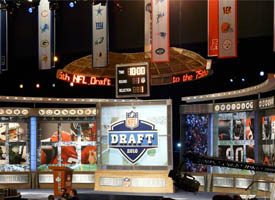 For the first time in over 50 years, Chicago is hosting this year’s NFL draft. Since 1968, the draft has been held at a variety of locations in New York City, with Radio City Music Hall hosting the event since 2006.
For the first time in over 50 years, Chicago is hosting this year’s NFL draft. Since 1968, the draft has been held at a variety of locations in New York City, with Radio City Music Hall hosting the event since 2006.
While tickets are required for the actual draft, local residents and attendees have access to a host of free events in Draft Town, an area set up in Grant Park offering live music, food, player autographs, interactive games and more. Draft Town is open today and tomorrow from 4:00 p.m. until 10:00 p.m. and on Saturday from 10:00 a.m. until 7:00 p.m.
The actual draft will take place at the historic Auditorium Theatre of Roosevelt University, with the first round beginning tonight at 7:00 p.m.
Learn more:
Draft Town Opens Tomorrow As NFL Draft Kicks Off In Chicago – Chicagoist
Draft Town presented by Oikos Triple Zero – NFL
Draft Town Schedule of Events – NBC Chicago
- Details
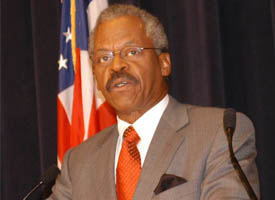 Bernard Shaw, who spent more than 20 years as an anchor for CNN, was born in Chicago. Growing up, Shaw spent much of his time reading local newspapers, contributing to his high school paper and reading the morning announcements.
Bernard Shaw, who spent more than 20 years as an anchor for CNN, was born in Chicago. Growing up, Shaw spent much of his time reading local newspapers, contributing to his high school paper and reading the morning announcements.
He served in the Marine Corps from 1959 until 1963 where he worked in its message center. After leaving the military, he attended the University of Illinois at Chicago, graduating in 1968.
His broadcasting career began with WNUS in Chicago as an anchor and reporter. He eventually left to work for the Westinghouse Broadcasting Company in Chicago. This transition led him to a position covering the White House for a few years before joining CBS in 1971. In 1977, he left CBS to take a position as the Latin American correspondent with ABC, where he had the opportunity to cover the Jonestown mass-suicide and interview Cuban President Fidel Castro.
Shaw began working for CNN shortly after its launch in 1980, having the opportunity to cover the protests at Tiananmen Square and the Gulf War. He also moderated the 1988 presidential debate between Michael Dukakis and George H. W. Bush as well as the 2000 vice-presidential debate between Dick Cheney and Joe Lieberman.
Shaw retired from CNN in 2001 and still occasionally appears on some of their segments.
Learn more:
Bernard Shaw – Encyclopedia Britannica





